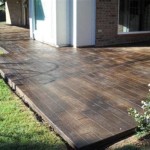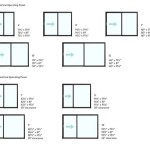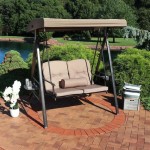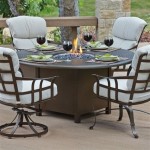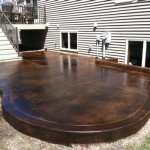DIY Patio Furniture Plans: Creating Your Outdoor Oasis on a Budget
Transforming an outdoor space into a relaxing and inviting patio area doesn't necessarily require a significant financial investment. Numerous DIY patio furniture plans are readily available online, offering cost-effective solutions for creating comfortable and stylish outdoor seating, dining, and lounging areas. By utilizing readily accessible materials and readily available free plans, homeowners can personalize their patios to reflect their individual tastes and needs without exceeding their budgets.
The appeal of DIY patio furniture extends beyond mere cost savings. The process allows for a high degree of customization, enabling individuals to adapt designs to fit specific spatial constraints, aesthetic preferences, or even unique material availability. Furthermore, engaging in DIY projects fosters a sense of accomplishment and ownership, resulting in patio furniture that is not only functional but also imbued with personal value and craftsmanship.
Understanding the Benefits of Using Free DIY Plans
Opting for free DIY patio furniture plans offers a multitude of advantages, primarily centered around accessibility and affordability. These plans eliminate the upfront cost of purchasing professionally designed blueprints, allowing individuals to allocate their resources directly towards materials and potentially specialized tools. The widespread availability of free plans across various platforms and websites provides a diverse range of design options, catering to various skill levels and aesthetic styles.
Free plans often come with detailed instructions, diagrams, and even instructional videos, guiding novice builders through each step of the construction process. This accessibility lowers the barrier to entry for individuals with limited woodworking or construction experience, empowering them to create functional and aesthetically pleasing patio furniture. Furthermore, the open-source nature of many free plans encourages adaptation and modification, permitting builders to personalize designs and incorporate unique features.
However, it's important to acknowledge the potential limitations associated with free plans. The quality and accuracy of free plans can vary significantly, ranging from professionally drafted documents to hastily sketched outlines. Therefore, careful evaluation and discernment are essential when selecting a suitable plan. Builders should prioritize plans that provide clear and comprehensive instructions, detailed material lists, and accurate diagrams to minimize the risk of errors or complications during the construction process.
Another consideration is the level of support provided with free plans. Unlike paid plans, which often include customer support or troubleshooting resources, free plans typically rely on community forums or online resources for assistance. Builders may need to be resourceful and proactive in seeking solutions to any problems encountered during construction.
Key Material Choices for DIY Patio Furniture
The selection of appropriate materials is crucial for ensuring the durability, longevity, and aesthetic appeal of DIY patio furniture. Several materials are well-suited for outdoor applications, each offering unique advantages and disadvantages in terms of cost, weather resistance, and ease of workability. The most common choices include wood, metal, and recycled materials.
Wood remains a popular choice for patio furniture due to its natural beauty, versatility, and relative ease of workability. Durable hardwoods such as teak, cedar, and redwood are particularly well-suited for outdoor applications due to their natural resistance to rot, decay, and insect infestation. However, these hardwoods tend to be more expensive than other wood options. Pressure-treated lumber offers a more affordable alternative, but it's crucial to ensure that the treatment is appropriate for outdoor use and safe for contact with humans and pets. Softwoods, such as pine and fir, can also be used for patio furniture, but they require regular maintenance and protection from the elements to prevent premature deterioration.
Metal offers exceptional strength and durability, making it a suitable choice for patio furniture that requires resistance to heavy use and extreme weather conditions. Aluminum is a lightweight and rust-resistant option, while steel provides greater strength but requires powder coating or other protective finishes to prevent corrosion. Wrought iron offers a classic and elegant aesthetic but is significantly heavier and more prone to rust. Metalworking requires specialized tools and skills, which may pose a challenge for novice DIY enthusiasts. Welding, cutting, and shaping metal typically necessitates specific safety precautions and expertise.
Recycled materials offer an environmentally friendly and cost-effective alternative for creating DIY patio furniture. Pallets, reclaimed wood, and repurposed metal components can be transformed into unique and stylish outdoor pieces. Using recycled materials reduces waste, conserves natural resources, and adds a distinctive character to the patio space. However, the availability and condition of recycled materials can vary significantly, requiring careful selection and preparation. Pallets, for example, should be inspected for structural integrity and treated to prevent pest infestations. Reclaimed wood may require sanding, cleaning, and refinishing to remove old paint or varnish and restore its natural beauty.
Regardless of the material chosen, it's essential to consider the local climate and weather conditions when selecting materials for DIY patio furniture. In regions with high humidity or frequent rainfall, water-resistant materials such as teak, cedar, or aluminum are preferred. In areas with strong winds, heavier materials or designs with greater stability are recommended. Adequate protection from the elements, such as the application of sealants, finishes, or covers, can significantly extend the lifespan of patio furniture made from any material.
Essential Tools and Equipment for DIY Patio Furniture Projects
Successful DIY patio furniture projects require a basic set of tools and equipment, ranging from hand tools to power tools, depending on the complexity of the designs and the materials being used. Having the right tools not only facilitates the construction process but also ensures safety and precision.
Essential hand tools include a measuring tape, a level, a square, a pencil, a hammer, a screwdriver set, and a saw. A measuring tape is crucial for accurate measurements, while a level ensures that surfaces are horizontal or vertical. A square is used to create accurate right angles, and a pencil is used for marking cutting lines and assembly points. A hammer is essential for driving nails, and a screwdriver set is used for fastening screws. A saw, either a hand saw or a power saw, is required for cutting wood or metal.
Power tools can significantly expedite the construction process and improve the accuracy of cuts and joints. A circular saw is ideal for making straight cuts in wood or metal, while a jigsaw is used for cutting curves or intricate shapes. A drill is used for drilling pilot holes and driving screws, and a sander is used for smoothing surfaces and removing imperfections. A power planer can be used to flatten uneven surfaces or create precise angles.
Safety equipment is paramount when working with power tools and potentially hazardous materials. Safety glasses protect the eyes from flying debris, while earplugs or earmuffs protect the ears from loud noises. A dust mask or respirator prevents inhalation of harmful dust particles, and gloves protect the hands from splinters, cuts, or chemicals. When working with metal, a welding helmet and gloves are essential for protecting the eyes and skin from the intense heat and sparks generated during welding.
In addition to basic tools and equipment, specialized tools may be required for specific projects. For example, a router can be used to create decorative edges or grooves in wood, while a biscuit joiner can be used to create strong and invisible joints. A miter saw is ideal for making precise angle cuts in wood, and a metal chop saw is used for cutting metal tubing or bars. The specific tools required will depend on the complexity of the project and the materials being used.
Prior to starting any DIY patio furniture project, it's essential to familiarize oneself with the proper operation and safety precautions for all tools and equipment. Consult user manuals, online tutorials, or experienced carpenters for guidance. It's also important to maintain tools in good working order and to store them safely when not in use.
By carefully selecting materials, utilizing readily available free plans, and investing in the necessary tools and equipment, individuals can create beautiful and functional patio furniture that enhances their outdoor living spaces without breaking the bank. The satisfaction of building furniture with one's own hands, combined with the cost savings and customization options, makes DIY patio furniture a rewarding and worthwhile endeavor.

Double Chair Plans How To Build A Bench With Table

Free Diy Furniture Plans To Build A Crate Barrel Inspired Reef Sofa The Design Confidential
:max_bytes(150000):strip_icc()/cherishedbliss-dcb2c5e4a8c64c12b0b16e85c88a22bd.jpg?strip=all)
23 Diy Patio Furniture Plans

Diy Patio Chair Plans And Tutorial Step By S Photos

Garden Chair Free Diy Plans How To Build Projects

Free Diy Furniture Plans How To Build An Outdoor Reef Sofa With Modifications For Cushions From Target The Design Confidential

Outdoor Chair Plans Easy To Build Free Construct101
:max_bytes(150000):strip_icc()/homemadebycarmona-386463f43539452b8b033a4108701959.jpg?strip=all)
23 Diy Patio Furniture Plans

Diy Outdoor Furniture 10 Easy Projects Bob Vila

Free Diy Furniture Plans To Build Customizable Outdoor The Design Confidential
Related Posts

